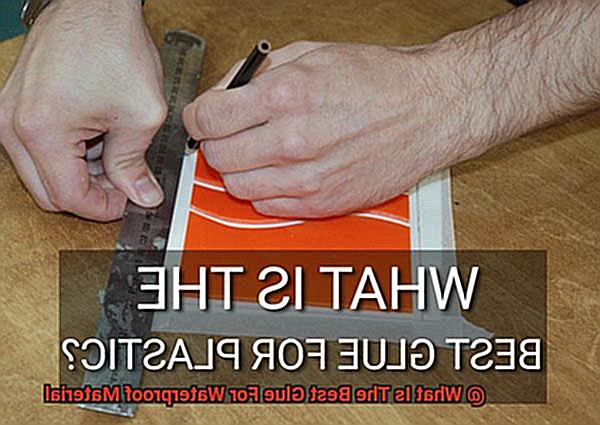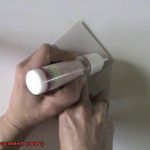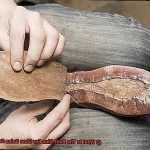Do you love spending time in the great outdoors but hate it when your gear gets ruined by water damage? Fear not, my friend. The solution to your problem is finding the perfect waterproof glue.
But with so many adhesives on the market, how do you know which one to choose? It’s not enough to grab any old glue and hope for the best. You need a glue that can withstand various weather conditions and water exposure to ensure that your gear lasts longer.
That’s where we come in. In this post, we’ll explore the best waterproof glues for different materials like rubber, leather, metal, plastic, and more. We’ll discuss their pros and cons, durability, resistance levels, and the best ways to apply them.
From repairing a leaky roof to fixing a cracked shoe sole or even patching up a punctured raft – we’ve got you covered. So let’s dive in and find the perfect waterproof glue for all your needs.
What is Waterproof Material?
Contents
Rain, snow, sleet, or hail – no matter what kind of weather comes your way, waterproof material is designed to keep you dry and comfortable. From outdoor gear to clothing and construction, waterproof materials are used in a variety of industries to repel water and prevent it from penetrating the surface.
Types of Waterproof Material
There are various types of waterproof materials available in the market. Some of the most common ones include:
- Rubber: Rubber is a simple and affordable option for waterproofing but can be heavy and uncomfortable to wear for extended periods.
- Vinyl: Vinyl is another affordable option that is easy to clean and maintain, but it can also be heavy and stiff.
- Neoprene: Neoprene is a synthetic rubber that provides excellent insulation against cold water and is commonly used in wetsuits.
- Gore-Tex: Gore-Tex is a high-performance fabric that is breathable and waterproof, making it a popular choice for outdoor gear.
How Waterproof Material Works

Waterproof material works by creating a barrier that prevents water from penetrating the surface of the material. This can be achieved in several ways:
- Coating: The material is coated with a layer of waterproof coating that repels water. This coating can be made from various materials such as silicone or polyurethane.
- Laminating: A layer of waterproof membrane is laminated to the underside of the fabric to create a barrier that prevents water from seeping through.
- Weaving: Some materials are woven in such a way that tiny gaps are created, allowing air to circulate but preventing water from seeping through.
Choosing the Right Waterproof Material
When selecting a waterproof material, it’s important to consider both its resistance to water and its breathability. Some materials may be more resistant to water than others, while some may have limitations in terms of breathability or durability.
It’s also important to note that waterproof materials are not always 100% waterproof. They may be water-resistant to a certain degree, but may not hold up in extremely wet conditions. Checking the manufacturer’s specifications and recommendations is always a good idea.
Types of Glue for Waterproof Material
Bonding waterproof materials requires a glue that can withstand exposure to water without losing its adhesive properties. With so many types of glue available, choosing the right one can be daunting. However, understanding the properties of different types of glue can help you make an informed decision.
Epoxy resin is a two-part adhesive that is known for its exceptional strength and durability. It forms a strong bond between various materials, including plastic, metal, wood, and ceramics. Epoxy resin is ideal for projects that require a strong bond and resistance to water.
Cyanoacrylate or super glue is a fast-drying adhesive that is commonly used for small projects. It forms a strong bond on non-porous materials like glass, plastic, and metal. However, it may not be suitable for bonding porous materials such as fabric or leather.
Silicone adhesive is a flexible and versatile option that can be used on surfaces exposed to water or high humidity levels. It maintains its strength even in wet conditions but may not be suitable for use in extreme temperatures.
Polyurethane adhesive is another versatile option that can bond a variety of surfaces, including metal, wood, and plastic. It has excellent water resistance and can maintain its strength even in wet conditions. However, it may require longer curing times than other types of adhesives.
Acrylic adhesive is a popular choice for bonding plastics and other non-porous materials. It has good water resistance and can maintain its strength even in wet conditions. However, it may not be suitable for use on porous materials such as fabric or leather.
When selecting the right glue for waterproof material, consider the types of materials being bonded and the conditions they will be exposed to. Following the manufacturer’s instructions carefully and allowing sufficient time for the adhesive to cure properly before exposing it to water or moisture is also important.
Advantages of Epoxy Adhesive
Say goodbye to that headache and hello to epoxy adhesive. Its many advantages make it the go-to choice for waterproofing materials.
The exceptional bonding strength of epoxy adhesive is one of its most significant advantages. It can withstand the harshest weather conditions and extreme temperatures, making it perfect for boats, swimming pool equipment, and outdoor furniture. Its versatility is another plus – it bonds to a wide range of surfaces like metals, plastics, ceramics, and wood. This makes it ideal for sealing leaky pipes or protecting outdoor patio furniture from the elements.
Epoxy adhesive’s resistance to chemicals and solvents is another key advantage. This property makes it an ideal choice for industrial settings where exposure to harsh chemicals is a concern. Its long shelf life and resistance to shrinking or cracking over time mean that your waterproofing efforts will last for years to come.
Perhaps best of all, epoxy adhesive is easy to apply and cures quickly. You can get your repairs or installations done fast and get back to enjoying your space without worrying about water damage.

To sum up, the benefits of using epoxy adhesive are numerous. Here are some of its advantages:
- Exceptional bonding strength
- Versatility in bonding to a wide range of surfaces
- Resistance to chemicals and solvents
- Long shelf life and resistance to shrinking or cracking over time
- Ease of application and quick curing
Advantages of Polyurethane Adhesive
As an expert in the field, I can tell you that this adhesive is a popular choice for bonding waterproof materials due to its many advantages.
Firstly, let’s talk about its incredible water resistance. Unlike other adhesives, polyurethane adhesive can withstand exposure to water without losing its adhesive strength. This makes it perfect for marine or outdoor applications where water resistance is essential. Say goodbye to your waterproofing woes with this reliable adhesive.
But that’s not all – polyurethane adhesive also has excellent chemical resistance. It can withstand harsh chemical environments where other adhesives may fail. Its high level of flexibility allows it to withstand vibrations and movements without cracking or losing its bond strength.
What sets polyurethane adhesive apart from other adhesives is its versatility. It can bond a variety of materials such as plastics, metals, and composites, making it a go-to choice for many different applications. Whether you need to bond a plastic pipe or a metal railing, polyurethane adhesive has got you covered.
And let’s not forget about its fast curing time. In production environments where time is of the essence, polyurethane adhesive can form a strong bond quickly and efficiently. This means less time waiting around for the adhesive to dry and more time getting things done.
Specialized Glues for Specific Materials
The key is to choose a specialized glue that is designed for the specific material you are working with. With so many options available, it’s important to do your research and select the right adhesive to ensure a strong and lasting bond.
Let’s delve into some of the popular waterproof materials and the specialized glues that work best for them:
- Rubber and Neoprene: Contact cement is an ideal adhesive for rubber or neoprene. This type of glue is applied to both surfaces, allowed to dry and then bonded together. The result is a robust, permanent bond that can withstand water and other liquids.
- Plastic: A two-part epoxy is recommended for bonding plastic. This adhesive consists of a resin and a hardener mixed together to create a strong, waterproof bond. Epoxy is particularly useful in filling gaps or irregularities in the surface of plastics.
- Metal: When working with metal, cyanoacrylate (super glue) can be used for quick bonding. However, if the metal parts are exposed to water or other liquids, a two-part epoxy or specialized metal adhesive may be a better choice.
- Fabrics and Textiles: Choosing the right glue for fabrics and textiles is crucial in avoiding damage during the bonding process. Fabric glue is designed specifically to bond fabrics without causing damage, while hot glue can be used for several applications but may not be suitable for all types of fabrics.
Selecting the Right Glue for Waterproof Material
Choosing the right glue is crucial to ensure that your bond remains strong and durable even after exposure to water or moisture. With so many types of adhesives available in the market, it can be overwhelming to know which one to choose. As an expert in this field, I am here to offer some valuable insights.
The first factor to consider when selecting a glue for waterproof material is the type of material you are working with. Different adhesives work better with specific materials such as metal, plastic, or fabric. It’s essential to choose an adhesive that is suitable for the material you are bonding to ensure a strong and long-lasting hold. Here are some of the most common waterproof materials and their recommended adhesives:
- Metal: Two-part epoxy or polyurethane adhesive
- Plastic: Cyanoacrylate (super glue) or polyurethane adhesive
- Fabric: Polyurethane adhesive or contact cement
Another critical factor to consider is the environment in which the bond will be exposed. If your project will be in contact with water or moisture, it’s essential to choose a waterproof adhesive that can withstand these conditions. Look for adhesives that are specifically designed for water resistance or have waterproof properties. Some of the best waterproof adhesives include:
- Silicone adhesive: ideal for sealing and bonding materials underwater
- Marine-grade epoxy: perfect for boat repairs and outdoor projects exposed to water
- Polyurethane sealant: excellent for sealing gaps and cracks in wet environments
The strength of the bond required for your project is also important. Some adhesives provide a stronger hold than others, so it’s crucial to choose one that matches your needs. For example, if you need a strong and durable bond, epoxies or polyurethane adhesives could be a good option as they provide excellent strength and durability.
When choosing an adhesive, it’s also important to consider the application method and drying time. Different adhesives have varying drying times, and some require specific application methods such as spray or brush-on. It’s important to choose an adhesive that suits your application method and provides ample drying time for you to make adjustments.
Follow Manufacturer’s Instructions Carefully
Ignoring these instructions can result in a weak bond or even damage to the material itself, which is why it’s crucial to pay attention to the details.
To start with, not all adhesives are created equal, and not all of them are suitable for use on waterproof materials. Before even thinking about applying glue, it’s essential to read the label carefully and ensure that it is suitable for the specific material you are working with. Some types of glue may require special techniques or preparation to work correctly on waterproof surfaces.
Once you have chosen the right adhesive for your waterproof material, pay close attention to any specific instructions provided by the manufacturer. These instructions can include application temperature ranges, recommended drying times, and optimal bonding pressure. Following these instructions to the letter will help ensure that your bond is strong and long-lasting.
But following the manufacturer’s instructions is just one piece of the puzzle. Another critical step is properly preparing the surface before applying the glue. This means making sure it is clean and dry, free of any dirt, dust, or moisture that can interfere with the bonding process. Skipping this step can lead to a weak bond that won’t hold up over time.
When it comes time to apply the glue, take your time and be sure to do so evenly and with the correct amount of pressure. Too little pressure can result in a weak bond, while too much pressure can cause the material to warp or bend. Applying the glue correctly will help ensure that your bond is as strong as possible.
Also Read: What is the best waterproof glue sealer?
Conclusion
In conclusion, protecting your outdoor gear from water damage is crucial for any adventurous individual. With countless adhesives available in the market, selecting the perfect waterproof glue can be overwhelming. However, choosing the right one that can withstand different weather conditions and water exposure is essential.
To make an informed decision, it’s important to understand the properties of various types of glue. Epoxy resin is perfect for projects requiring a strong bond and resistance to water, while polyurethane adhesive is versatile and has excellent water resistance. Additionally, specialized glues are available for specific materials such as rubber, plastic, metal, and fabrics.
When selecting a glue for waterproof material, consider factors such as the type of material being bonded, the environment in which it will be exposed, and the strength of the bond required. Following manufacturer instructions meticulously when applying the adhesive ensures a robust and long-lasting bond.
Choosing the right waterproof glue can make all the difference in ensuring your gear lasts longer and remains protected from water damage. So take some time to research your options thoroughly and find the perfect adhesive that suits all your needs.






